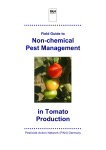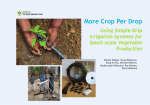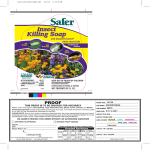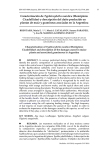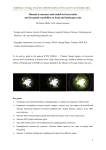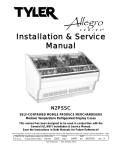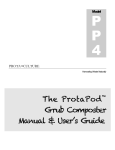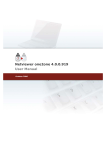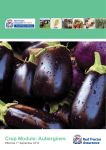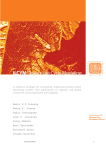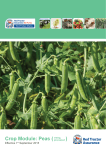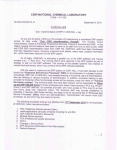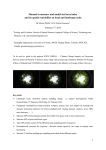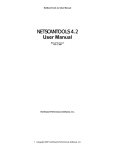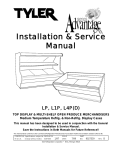Download - Online Information Service for Non
Transcript
Field Guide to Non-chemical Pest Management in Mango Production Pesticide Action Network (PAN) Germany Field Guide to Non-chemical Pest Management in Mango Production Pesticide Action Network (PAN) Germany Hamburg, 2005 This publication is prepared by PAN Germany for PAN UK. Pesticide Action Network (PAN) Founded in 1982, the Pesticide Action Network is an international coalition of over 600 citizens groups in more than 60 countries, working to oppose the misuse of pesticides and to promote sustainable agriculture and ecologically sound pest management. PAN Germany was established in 1984 as part of this global network and has continually been involved in initiatives to reduce the use of hazardous pesticides and to promote sustainable pest management systems on national, European and global levels. Acknowledgements First, we want to express our gratitude to the universities and organisations that have given the permission to use their photos for the OISAT project. (For more details see p. 29) We also wish to thank all the individuals, groups and organizations that have prepared the bases for the most control measures presented in this field guide, may it have been by preserving traditional experience, on field trials, on field research or in the lab. © Pesticide Action Network (PAN) Germany Nernstweg 32, 22765 Hamburg, Germany Phone: +49 (0) 40 – 399 19 10-0 Fax: + 49 (0) 40 – 390 75 20 Email: [email protected] Internet: www.pan-germany.org www.oisat.org Prepared by: Dr. Jewel Bissdorf Editor: Carina Weber Layout: Reginald Bruhn Hamburg, August 2005 Apart from the photos, permission is granted to reproduce any and all portions of this publication, provided the publisher, title, and editor are acknowledged. Index Prologue............................................................................................................................................7 How to use this field guide...............................................................................................................8 General recommendations ...............................................................................................................9 Insects/Mites ...................................................................................................................................10 Fruit fly .........................................................................................................................................10 Mango leafhoppers .......................................................................................................................12 Mango shoot caterpillar.................................................................................................................13 Mango tip borer ............................................................................................................................14 Mealybugs ....................................................................................................................................14 Mealybugs ....................................................................................................................................15 Scales ..........................................................................................................................................16 Diseases ..........................................................................................................................................17 Anthracnose .................................................................................................................................17 Pink disease .................................................................................................................................17 Scab.............................................................................................................................................18 Stem-end rot.................................................................................................................................18 Natural enemies ..............................................................................................................................19 Braconids .....................................................................................................................................19 Damsel bugs.................................................................................................................................20 Encarsia .......................................................................................................................................20 Ground beetle...............................................................................................................................21 Hoverfly ........................................................................................................................................22 Lacewing ......................................................................................................................................23 Ladybird beetles ...........................................................................................................................24 Rove beetles.................................................................................................................................25 Spider...........................................................................................................................................26 Tachinid fly ...................................................................................................................................27 Photo credits...................................................................................................................................29 Alphabetical list of the mentioned control methods .....................................................................29 References ......................................................................................................................................30 Field Guide to Non-chemical Pest Management in Mango Production Prologue Pesticides worth more than 30 billion US dollar are intentionally released into the global environment every year. A high proportion of these is highly toxic and has immediate adverse effects on human health, wildlife, local food sources such as cattle or fish, beneficial insects and biodiversity. Some of them have chronic effects including cancers, reproductive problems, birth defects, hormonal disruption and damage to the immune system. Impacts come from direct exposure in use, spray drift, washing work clothes used while spraying, home pesticide storage, pesticide dumps, and persistence in the environment. Overall aim of the international Pesticide Action Network (PAN) is to eliminate the use of hazardous pesticides, reduce overall use, risk and dependence on pesticides, and increase support for community-based control over a sustainably produced food supply. PAN is committed, in its projects, strategies and campaigns to place pesticide concerns in the broad political and economic context in ways that will advance the fight against rural poverty and enhance pro-poor development and ethical trade. PAN aims to help local communities use the initiatives to benefit their day-to-day lives. PAN Germany is part of the international Pesticide Action Network. It is supporting nonchemical pest management on tropical crops that are commonly grown by small landholder farmers through the project: Online Information Service for Non-chemical Pest Management in the Tropics, OISAT (www.oisat.org). OISAT is a web-based system to distribute information on non-chemical pest management that is easy to read and easy to understand. Information provided via www.oisat.org is relevant to small-scale farmers who intend to produce crops using safer and more affordable non-chemical pest management practices. It provides varied information on how to lower the cost of production based on recommended insect/mites pests, disease, and weeds control methods. This ‘Field Guide to Non-chemical Pest Management in Mango Production’ is an excerpt taken from the website www.oisat.org. It enables to provide farmers with practical guides and alternatives to eliminate the use and their dependence on synthetic pesticides for the management of mango pests. The recommended practices are safer, more affordable, and easy to follow. Most of the farm practices, the farmers can do by themselves and the materials that are needed are found in their backyards or in their kitchens or can be purchased in the local agricultural suppliers. Carina Weber (Executive Director PAN Germany) Pesticide Action Network (PAN) Germany 7 Field Guide to Non-chemical Pest Management in Mango Production How to use this field guide This field guide is designed to make the control of mango pests as easy as possible. Each pest included has a brief description of its lifecycle, damage it causes, and the control measures. It is very important to know how the insect/mite pest develops because the adult does not always cause the damage and sometimes it is not even found where the damage occurred. Also, as not to confuse you with the beneficial ones, a separate description of the natural enemies and their conservation and management are discussed at the last part. Included in the control measures are cultural practices, physical control, plant extracts, other homemade solutions, and other practical methods. For example, you notice that the mango fruits have black spots when you’re out in the field. What would you do? First, have a closer and careful examination of your plant. If you find the pest and can’t identify it, turn the following pages and look at the illustration of an insect and/or the damage or symptom in each pest entry. Once you have identified the pest, look into the corresponding control measures on how to lessen its population density. You have various options like: cultural practices (e.g. removal of weeds); physical control (e.g. handpicking); plant extract (e.g. neem spray); other homemade solution (e.g. soap spray); other method (use of baits). However, with every effort made to provide you with complete information on the natural pest control in Mango Production, the recommendations may vary from every location. It is highly recommended that you have to try the various control practices in small scale especially for the plant extracts and other homemade solutions, in order to make adjustments that are adaptable to your local farm conditions before going into large scale application. And best of all, always keep farm records to have a list of successes and failures in each time you grow a crop! 8 Pesticide Action Network (PAN) Germany Field Guide to Non-chemical Pest Management in Mango Production General recommendations Throughout this field guide you will find suggestions for lessening the pests’ population before they have control over your plants. To make a plan for you to grow a healthy crop, the following tips are the steps you ought to take: 1. Learn to identify the pests and other causal agents and the natural enemies 2. Select the proper mango variety that is well adapted to your local conditions 3. Always select good and diseased-free seedlings. 4. Have a healthy soil, and always keep in mind that over-fertilizing isn’t necessarily better 5. Plant intercrops to improve the field’s diversity and to encourage natural enemies 6. Follow the recommended pruning practices 7. Always practice proper plant sanitation by removing and pruning infested plant parts and filed sanitation by keeping the area free of weeds and other plant residues. 8. Monitor your plants regularly 9. When in doubt, always ask for assistance from your local agriculturists When controlling pests using the plant extracts and other homemade solutions, the following are the standard procedures for their preparation and application: 1. Select plants/plant parts that are pests-free. 2. When storing the plants/plant parts for future usage, make sure that they are properly dried and are stored in an airy container (never use plastic container), away from direct sunlight and moisture. Make sure that they are free from molds before using them. 3. Use utensils for the extract preparation that are not used for your food preparation and for drinking and cooking water containers. Clean properly all the utensils every time after using them. 4. Do not have a direct contact with the crude extract while in the process of the preparation and during the application. 5. Make sure that you place the plant extract out of reach of children and house pets while leaving it overnight. 6. Always test the plant extract formulation on a few infested plants first before going into large scale spraying. 7. Wear protective clothing while applying the extract. 8. Wash your hands after handling the plant extract. Since mango has a large canopy. The use of plant leaf extracts is advised for a few trees only, unless the recommended ones are bountiful in your area. Pesticide Action Network (PAN) Germany 9 Field Guide to Non-chemical Pest Management in Mango Production Insects/Mites Fruit fly Damage Adults and larvae-maggots cause fruit damage. Egg-laying females puncture the fruits leaving scars and holes on the fruit surface. Larval feeding causes premature fruit drop and destroys the pulps of the fruit. The fruit eventually rots making it unsuitable for harvesting and human consumption. Description Eggs of fruits flies are small, white, and slender. These are laid, or inserted into fruit in groups of up to 37 eggs. They hatch within 2-4 days. Larvae are cylindrical, elongate, narrowed, and somewhat curved downward with their mouth hooks at the head. The larvae live and tunnel through the fruit, feed on the pulp, and continue feeding inside the fruit. They jump rather than crawl. When the larvae are ready to pupate, they emerge from the fruit and drop to the ground. Pupae occur in the soil beneath the host plant. The pupal stage lasts for about 10 days. Adult fruit flies are very small insects which lay their eggs in various plant tissues. Wide heads, black or steely green or blue bodies, bright greenish to bluish eyes, and wings that are usually mottled brown or black, characterize the Tephritidae. The Drosophilidae are yellowish and in the wild are largely found around decaying vegetation. The larvae living in fruit feed on the yeasts growing in the fruit. A female adult lays eggs in groups within the fruit and may lay as many as 1,200 eggs in her lifetime. The average life span of the adult is about 30 days. The life cycle of the fruit fly ranges from 12-28 days depending on the climatic condition. In countries with high temperatures, its life cycle is 12 days and longer in areas with cool weather. Important fruit fly species Oriental fruit fly. The adult Oriental fruit fly is somewhat larger than a housefly, about 8 mm in length. The body color is generally bright-yellow with a dark T-shaped marking on the abdomen. The wings are transparent. The female has a pointed slender ovipositor use to deposit eggs under the skin of host fruit. Eggs are minute cylinders laid in batches. Medfly. The adult Medfly is slightly smaller than a common housefly and is very colorful. It has darkblue eyes, a shiny-black back, and a yellowish abdomen with silvery cross bands. Its wings, normally drooping, display a blotchy pattern with yellow, brown, and black spots and bands. This adult Medfly attacks all fruits and it is the most widespread and destructive. Melon fly. The adult Melon fly is 6-8 mm in length. Distinctive characteristics of the adult are the wing patterns and long third antennal segment. The back of the thorax is reddish-yellow with light-yellow markings and without black markings. Its head is yellowish with black spots. Soon after emergence, the Melon fly begins looking for food. The adults are capable of very long flights and can fly as far as 3060 km. The melon fly is rated as one of the world's most serious pests and the most important pest of vegetables especially melons and squashes. Control measures Cultural practices 1. 2. Remove fruits with dimples and oozing clear sap. This method is more effective although laborious than picking rotten fruits from the ground as the maggots may have left the fruits to pupate. Harvest crops early when mature green. This is the stage of maturity when crops are not susceptible to fruit fly attack. 3. Pick overripe fruits. These are good breeding sites for fruit flies. 4. Practice crop and field sanitation. Collect and destroy fallen and damaged ripe fruits. Do not put collected damaged fruits in compost heaps, instead feed to pigs or poultry, or bury to eliminate all sources of possible breeding sites. 10 Pesticide Action Network (PAN) Germany Field Guide to Non-chemical Pest Management in Mango Production Physical control 1. Bagging the fruits To make your own bags, cut old newspapers measuring 15 x 22 cm or 12.5 x 27.5 cm. Double the layers, as single layer breaks apart easily. Fold and sew or staple the sides and bottom of the sheets to make a rectangular bag. To bag a fruit, blow in the bag to inflate it. Remove some of the fruits, leaving 1 on each cluster. Insert one fruit per bag then close the bag using coconut midrib or firmly tie top end of bag with string or wire. Push the bottom of the bag upwards to prevent fruit from touching the bag. Use a ladder to reach as much fruits as possible. Secure the ladder firmly on the ground and for bigger and higher fruits trees, secure or tie the ladder firmly on big branches. Start bagging the mango fruit 55-60 days from flower bloom or when the fruits are about the size of a chicken egg. When using plastic bags, open the bottom or cut a few small holes to allow moisture to dry up. Moisture trapped in the plastic bags damage and/or promotes fungal and bacterial growth that caused diseased-fruits. Plastic also overheats the fruit. Bags made of dried plant leaves are good alternatives to plastic. the neck. Also make a hole on the lid, big enough for the string or wire to pass through. Insert a string or wire at the lid's hole. Place the bait inside the bottle. Hung traps in a shady part of the tree just above the lower leaves. Replace the bait at least 2 times in a week. Fresh bait is often attractive to the flies. Fruit fly baits Ripe banana peel cut into small pieces and mixed with sugar, flour, and water Mixture of 1 tsp vanilla essence, 2 tbsp ammonia, ½ cup sugar, and 2 liters of water Mixture of 1 cup vinegar, 2 cups water, and 1 tbsp of honey. Mixture of sugar, soya sauce, and ammonia. 3. Yellow sticky traps baited with vials containing a ratio of 1 part ammonia and 1 part of water Plant extracts Basil leaf extract Neem seeds extract Remove the bags during harvest and dispose them properly. 2. Fruit fly trap To make your traps, you need 1-liter used plastic bottles. Heat an iron rod to make holes on Neem seeds extract Method of preparation Basil leaf extract Method of preparation Grind leaves 50 g of basil leaves Soak overnight in 2-3 liters of water Strain Add 8-12 ml soap Stir well Pests controlled Caterpillars Fruit flies Red spider mites Red scales Spotted leaf beetles Fungal diseases Nematodes Pound gently 3-5 kg of de-shelled neem seeds. Place pounded seeds in a clay pot. Add 10 liters of water. Cover the mouth of the pot securely with the cloth and leave it as such for 3 days. Strain to get clear extract. Dilute 1 liter of neem seed extract with 9 liters of water. Add 100 ml of soap. Stir well. Pests controlled Most agricultural pests Pesticide Action Network (PAN) Germany 11 Field Guide to Non-chemical Pest Management in Mango Production Mango leafhoppers Damage Both the nymphs and the adults feed on the plant sap of the flowers, leaves, tender shoots, and newly formed fruitlets. They then suck out the liquid contents leaving behind the dead and empty cells which are small, white spots. The affected flower heads turn brown and dry up, and fruit setting is affected. Some damage may also occur through egg laying into the leaves and flower stems. Heavy feeding results to ‘hopperburn’ which is caused by the toxic effects of the insects’ saliva. It also causes mosaic virus disease as the pests are carriers of the virus. Leafhoppers produce large amounts of a sugary liquid waste called honeydew. A fungus, called sooty mold, grows on honeydew deposits that accumulate on leaves and branches, turning leaves and branches black. The appearance of a sooty mold on plants is an indication of a leafhopper infestation. Description The eggs are laid inside the soft plant tissue on the underside of the leaves. They are elongate or curve, whitish to greenish, and about 0.9 mm long. Eggs hatch in about 10 days. The nymphs look similar to the adults but are very small, pale yellow-green, and wingless. They undergo five nymphal stages. Their cast skins usually remain on the lower surface of the leaf. Nymphs have the ability to walk sideways, forward or backward at rapid paces. Adults are small, elongate, wedge-shaped insects about 3-4 mm long. They hop fast, fly quickly, and can run in all directions when disturbed, hence the name leafhopper. Many leafhoppers look alike but mango leafhoppers are brown in color. Control measures Plant extracts Garlic oil spray Neem oil spray Garlic oil spray Neem oil spray Method of preparation Method of preparation Chop finely 100 g of garlic. Soak the chopped garlic in mineral oil for a day. Add ½ liter and 10 ml of soap. Dilute filtrate with 10 liters of water. Constantly shake the container or stir the extract while in the process of the application to prevent oil from separating. Add 30 ml of neem oil into 1 liter of soapy water. Constantly shake the container or stir the extract while in the process of application to prevent oil from separating. Pests controlled Flea beetles Gall midge Leafhoppers Pests controlled Leafhoppers Imported cabbage worm Squash bugs Whiteflies 12 Pesticide Action Network (PAN) Germany Field Guide to Non-chemical Pest Management in Mango Production Mango shoot caterpillar Damage Larvae feed on the growth flushes at the nursery stock, young trees, and top-worked trees. Occasionally, the fruit stalks and young fruits are damaged. The sudden death of a part of a branch, crackedbranch, and falling off of a branch are indications of the attack. Description The eggs are lemon-colored and are laid singly on both leaf surfaces on new growths. They hatch in 3 - 5 days. The larva is light to pale-green with purple dots that sometimes has the same color as that of the young tender leaves. The larval development takes about 8 - 10 days. Pupae are dark-brown with no distinguishing lumps or lobes. It is found among the soil debris or near the soil surface. Pupation takes about 16 - 20 days Adult moths are russet-brown with light-brown markings across the forewings and have a wingspan of 25 mm. The forewings are dull-purple with several darker stripes, including a dark-gray purple spot near the apical end while the hindwings are white with a broad smoky-brown or purple-gray margin. Control measures Neem leaf extract Physical control Method of preparation Prune the affected plant parts and then burn or bury them Pound gently 1-2 kg of neem leaves. Place in a pot. Add 2-4 liters of water. Cover the mouth of the pot securely with the cloth and leave it as such for 3 days. Strain to get clear extract. Dilute 1 liter of neem leaf extract with 9 liters of water. Add 100 ml of soap. Stir well. Plant extracts Ginger, garlic, and chilli extract Ginger, garlic, and chilli extract Method of preparation Soak 50 g of peeled garlic overnight in 10 ml mineral oil. Combine garlic, 25 g of green chilies, and 25 g of ginger. Add 50 ml of water to the mixture. Grind them. Add 3 liters of water. Pests controlled Aphids Armyworm Cotton bollworm Caterpillars Corn earworm Fruit borers Leafminers Shoot borers Thrips Tomato fruitworm Whiteflies Pests controlled Aphids Colorado potato beetles Grasshoppers Grubs Japanese beetles Leafhoppers Locusts Plant hoppers Scales Snails Thrips Weevils Whiteflies Pesticide Action Network (PAN) Germany 13 Field Guide to Non-chemical Pest Management in Mango Production Mango tip borer Damage The larvae feed on the fruiting twigs and panicles. They bore into and/or near the tips of the young shoots and tunnel their way to the basal parts causing the tips to shrink and dry-up Description Eggs are creamy-white that are found on the flower stem and young shoots. They hatch after 3 7 days. The larva is pale-green and locates itself in the tunnel it bores. It comes out to feed on soft and tender tissues of new growths. The larval period is 8 - 10 days. Pupa is brown and found among the plant debris and on the upper portion of the soil. The adult is grayish-black and about 8-10 mm in size. Both sexes have the same body characteristics except that the male has a black ventral portion on its abdominal segments. Control measures Physical control Prune the affected plant parts and then burn or bury them Plant extracts Ginger, garlic, and chilli extract (refer to p. 13) Neem powdered seed extract Method of preparation Add 50 grams of powdered kernel in 1 liter of water. Let it stand for 6 hours but not more than 16 hours. Add soap and stir. Constantly shake the container or stir the extract while on the process of application. Pests controlled Aphids American bollworms Cotton leaf rollers Diamondback moths Grasshoppers Leafhoppers Leafminers Red locusts Mexican bean beetles Whiteflies 14 Pesticide Action Network (PAN) Germany Field Guide to Non-chemical Pest Management in Mango Production Mealybugs Damage Leaves are distorted (rolled or folded), stunted, and yellow. Heavy infestation causes dropping of leaves and flowers and reduces fruit setting. Attacked developing fruits drop prematurely. Like the other sap-feeding insects, mealybugs excrete (eliminate) large quantities of honeydews, which promote sooty mold that caused blackenedmalformed leaves, stems, and fruits. Infested fruits are unmarketable. Description Eggs are oval, yellow, and are laid in an ovisac of sculpted white wax. Newly hatched nymphs are pale-yellow and have two waxy filaments on the posterior end. As they grow, the white mealy wax coverings on their bodies increase and white lateral processes are formed. Wing pads appear in the prepupal stage and gradually increase in size during the pupal stage. The adults have white mealy wax coverings, hence the name. Control measures Physical methods 1. Spray a steady stream of water (reasonably high pressure) on the host plant to knock-off mealybugs. Once on the ground, the fallen ones will be available to ground predators and this will also make their return to the plant difficult. Wetting mealybugs encourages fungal pathogens that may infest on them. 2. Handpicking Rub or handpick mealybugs from affected plants to reduce populations. They release chemicals that signal others to drop and leave. 1. Pruning Prune affected plant parts to remove mealybugs. Remove and destroy heavily infested plant. This will cut down sites and reduce future populations. Plant extracts Chili spray In a pot, boil 4 cups of ripe pods or 5 cups of chili seeds in water for 15-20 minutes. Take the pot from the fire and add 3 liters of water. Cool and strain. Add 30 grams of soap. Stir well. Strain. Soap spray This spray material Method of preparation also controls fruit flies. Other methods Soap spray Mix 2½ tbsp of liquid soap to a gallon of water. Stir well. Another method is to mix 1 tbsp of dishwashing detergent with 1 cup of cooking oil, to make a stock solution. For a gallon of spray, add 5-8 tbsp of stock solution to a gallon of water. Pests controlled Ants Leafhoppers Mealybugs Psyllids Scales Spider mites Thrips Whiteflies and Plant diseases Pesticide Action Network (PAN) Germany 15 Field Guide to Non-chemical Pest Management in Mango Production Scales Damage Scales remove plant saps by using their sucking mouthparts. Leaves become stunted and turn yellow and the twigs and branches dieback. Some scale species produce honeydews which they secrete while feeding. Honeydews on fruits, leaves, twigs, branches, and barks attract black sooty molds to feed and grow, causing these plant parts to blacken. Description 1. Armored scales (Diaspididae) Armored scales are small, about 3 mm long. Their colors vary from white, yellow, gray, reddish or purplish. Adults are oval or round, hard bumps, and sometimes bearing a nipple or dimple in the center. They do not produce honeydews but they secrete armor wax in an oyster shell or circular pattern. They remain attached to the host plant when shells are lifted up. 2. Soft Scales (Coccoidae) The eggs are covered or found under the mother scales. Eggs hatch into crawlers (nymphs), which are flattened and looking like dusts on the plant surface. Adult females are either oval or round, soft, legless bumps, and are wingless. Males are tiny yellow-winged soft scales. Soft scales secrete honeydews which attract ants. The shells of the soft scales are not left on the plant when lifted up. The soft covering they secrete cannot be separated from the scale's body. Soft scales typically move between branches and leaves during their lifecycle. Control measures Other solutions Horticultural oil sprays Horticultural oils are concentrated and must be mixed with water. Spray 2% solution against insects and mites. To make a 2% solution, pour 1/3-cup oil into a 1-gallon container, and then fill with water to make a 1-gallon solution. For a 3% solution, start with ½ cup of oil. Apply successive sprays at least 6 weeks apart. You can apply 1% oil solution by mixing 2.5 tbsp of oil in 1 gallon of water. remaining on the plant because this will ensure protection against newly hatched scales. To dislodge living scales is to use a forceful jet of water to 'power wash' them from barks. Application of Vaseline, camphor, eucalyptus oils should be tested on small area, prior to large scale spraying because some leaves are sensitive to these oils. If done for the first time, ask for assistance from your local agricultural office. Following the mineral oil spray, use a highpressure water jet treatment to dislodge dead scales from trees. It is important to remove the dead scales 16 Pesticide Action Network (PAN) Germany Field Guide to Non-chemical Pest Management in Mango Production Diseases Anthracnose Symptoms Infected leaves have shot-hole spots. Affected flowers and young fruits are blighted and fall down. On green fruits, tiny brown spots develop that will only enlarge after harvest. The sunken spots enlarge on a ripening fruit and found anywhere on the peel in tear-shaped patterns. Eventually, the whole fruit rots and fungal fruiting bodies are formed on the rotten surfaces. Prevention and control Hot water treatment Dipping newly harvested fruits in hot water (53°C for 5-10 minutes) minimizes anthracnose and stem-end rot infestations. Anthracnose will be reduced by 83% and stem-end rot by 100%. water should have a uniform temperature within the tank to be effective. After dipping the fruits in hot water, dip them in tap water to about two hours or place them in a well ventilated room to cool down. To facilitate heat water treatment, you need dipping tank, thermometer, and wire baskets. The Pink disease Copper spray (Bordeaux mix) Method of preparation Symptoms The first stage of infection is small cracks with fungal growth are found on the bark. The bark becomes pink and rotten as the disease develops. In heavy infestation, the disease that surrounds the trunk eventually withers and dies. Prevention and control 1. Prune the infected branches. Disinfect the cut surfaces with bleach solution at a ratio of: 1 part bleach and 5 parts water. When the branch is dry, varnish it with house paint. 2. Copper spray Mix 3 ½ tbsp of copper sulphate, 10 tbsp of hydrated lime and 1 gallon of water (4 liters of water) in a plastic bucket Stir using wooden stick Pests controlled Flea beetles Anthracnose Bacterial blight Bacterial wilt Black spot Downy mildew Late blight Powdery mildew Rust and many other disease causing pathogens Cautions Use only plastic or any non-corrosive containers Shake or stir to prevent extract from clogging Spray only on dry and sunny day, preferably early morning Pesticide Action Network (PAN) Germany 17 Field Guide to Non-chemical Pest Management in Mango Production Scab Symptoms Attacked leaves have dark-brown to black circular and somewhat angular lesions. As the lesions enlarge, they become white to gray with narrow and dark margins. Attacked stems have grayish and irregular blotches. Infected fruit's skin has blemishes. The early infection appears as grayish-brown lesions with irregular margins. As the disease develops, it causes cracked and corky appearance. Even if the disease is only found on the skin, the numerous spots lessen the appeal of the consumers. Prevention and control Hot water treatment (refer to p. 17, Anthracnose, prevention and control) Stem-end rot Symptoms The infected fruit has initially violet lesion at the stem-end, turning light-brown, and finally becoming black. The inner tissues of the fruit become soft and watery. Prevention and control Hot water treatment (refer to p. 17, Anthracnose, prevention and control) 18 Pesticide Action Network (PAN) Germany Field Guide to Non-chemical Pest Management in Mango Production Natural enemies Braconids Hosts Ants, aphids, armyworms, beetle's larvae, bollworms, cabbageworms, caterpillars, codling moths, corn borers, cutworms, imported tent caterpillars, leafhoppers, leafminers, maggots, midges, plant bugs, scales, tomato hornworms, weevils, and many more. Description Eggs and larvae of Bracons are found inside the hosts' bodies. The larvae are tiny, cream-colored grubs that feed in or on other insects. Larvae molt five times and undergo 5 instars. Pupae of some species live and pupate within the host until they mature; others pupate in silken cocoons on the outside of the body of the host, while others spin silken cocoons away from the host. Adult wasps are tiny, about 2.5 mm in size, slender black or brown with threadlike waists. Female wasps lay eggs into the eggs of hosts' pests but prefer caterpillars' bodies. In cases where aphids are the host pests, aphids are not killed instantly. Aphids continue to feed on plants tissues until the Braconid larvae inside their bodies completely consume them. The fully-grown Braconid larvae cement the dead aphids to the leaf surface making aphids' shells black and mummified. About a week later, the adult Bracon wasps cut round holes in the mummies and emerge. The empty mummies remain on the leaf. The presence of mummies in a colony of aphids is a sign that Bracons are present. Conservation Adult Bracons feed on nectar, honeydew, or pollen before laying eggs. Dill, parsley, yarrow, zinnia, clover, alfalfa, parsley, cosmos, sunflower, and marigold are flowering crops that attract the native braconid populations and provide good habitats for them. Pesticide Action Network (PAN) Germany 19 Field Guide to Non-chemical Pest Management in Mango Production Damsel bugs Hosts Aphids, armyworms, asparagus beetle, Colorado potato beetle eggs and nymphs, corn earworm, corn borer, imported cabbageworm, leafhoppers, mites, moth eggs, sawfly larvae, and tarnished plant bug nymphs. Although they can survive for about two weeks without food, they will eat each other if no other prey is available. Description Eggs are deposited in soft plant tissues where they are so difficult to find. Nymphs resemble adults and develop through 5 nymphal stages in about 50 days. Adults are tiny, about 2-4 mm long, with slender bodies and are yellowish or gray or reddish-brown in color. They have piercing-sucking mouthparts, a 4- segmented beak, elongated heads, and 4 long segmented antennae. They are fast runners with long slender back legs and enlarged forelegs for grasping prey. They are commonly found in most agricultural crops, especially legumes, throughout the year. Adults begin laying eggs soon after emergence. Conservation They prefer to live in soybeans, grassy fields, and alfalfa. You can collect damsel bugs in alfalfa fields and release them around your garden. Encarsia Hosts Various whitefly species Description Eggs are found inside the body of the host larva. The larvae develop within the whitefly larvae passing through four larval stages. The host pupa turns black when Encarsia pupates inside the whitefly. Adult wasps emerge from the parasitized pupae by chewing a hole in the top of the scale. Adults are very tiny wasps, about 1 mm in size. These parasitic wasps can look actively and effectively for whiteflies. They can cover distances of 10-30 m looking for hosts. Adult females attack young whitefly larvae by stinging and laying eggs inside them. An adult female wasp can lay 60-100 eggs. The life cycle is completed within 2-4 weeks depending on the climatic conditions. Adults can live for 30 days but are active for about 10 days. Adult wasps feed on honeydew and the body fluids of whitefly larvae. They also feed directly on the scales. However, honeydew restricts their movements so that it is difficult for them to have a wider feeding coverage. With the exception of the adult, all stages of Encarsia occur inside the whitefly host. 20 Pesticide Action Network (PAN) Germany Field Guide to Non-chemical Pest Management in Mango Production Conservation Conserving natural enemies is probably the most important practice farmers could do. Practicing multiple cropping (including flowering crops) provides pollen, honeydew, and nectar for adult wasps. The practice can increase the diversity of habitats that provide shelter and other food sources to the natural enemies. Some Encarsia species are native to crop production environments. When introduced, they have the tendency to adapt to the local environments. Weekly field monitoring or a visual inspection of plants is important to notice the presence of pests and beneficial insects in order to consider when to make pest management decisions. Ground beetle Hosts Slugs, snails, cutworms, cabbage root maggots, grubs and insect pupae, and small caterpillars Description Eggs are normally laid singly in the soil. Larva is elongated and tapered toward the end, worm-like in appearance and have a large head directed forward. Pupa is brownish black, small and found in the soil. Adult ground beetles or Carabids are about 26cm long, dark shiny brown to metallic black, blue, green, purple, or multi-colored. They vary in shapes,- from elongated to heavy-bodied, - tapered head end with threadlike antennae, and have a ringed wing cover. Their heads are usually smaller than their thorax. Both adults and larvae have strong pincher-like mandibles. They have prominent long legs, which make them fast moving insects. Most species are nocturnal and they hide during the day in soil crevices, under rocks and stones, decaying logs, leaf litter, or composting materials. When disturbed or when other vertebrates prey upon them, they emit an odor or gas, as a type of defense mechanism, preventing them from being eaten by other predators. Ground beetles live on or below the ground, hence the name. Development from the egg to the adult stage takes about a year, although adults may live 2 to 3 years or longer. Conservation 1. Practice mulching in some sections of your field to provide a habitat for the ground beetles. 2. Provide permanent beds and plantings to protect population. 3. Plant white clover and/or amaranth as ground covers. perennial Pesticide Action Network (PAN) Germany 21 Field Guide to Non-chemical Pest Management in Mango Production Hoverfly Hosts Aphids, thrips, psyllids, scale insects, small caterpillars, and larvae of Heliotes Description Eggs are tiny, about 1mm in size, ovateshaped, and glistening white. These are found laid singly and close to the developing aphid colony in the leaves, shoots, or stems of the plants. They hatch within 2-3 days. The larvae, known as Syrphids, are legless slug like maggots, about 1-13mm in length depending on their larval stages. They usually have a mottled gray, beige, or light green color. They lift their pointed heads to look for preys. Once preys are located, their mouthparts suck out the contents of the preys. Larvae are frequently found feeding on aphids in the sheltered and curled portion of leaves. They blend well with their habitat and therefore they must be looked for closely to locate them. Pupae are teardrops shaped and are found in the soil surface or in the plant's foliage. Adult hoverflies are true flies with only two wings instead of four which most insects have. Adults are large and beautiful insects about 13 mm long. They have a dark head, a dark thorax, and a banded yellow and black abdomen. They closely resemble bees or wasps rather than flies. Their habit of hovering like humming birds gave them the names hoverflies or flower flies. They feed on pollen, nectar, and honeydew. They are good pollinators. Conservation Hoverflies are attracted to all flowering plants but even more so to small-flowered herbs like wild mustard, coriander, dill, lupines, sunflower, and fennel. It is advisable to have multiple crops as adults basically feed on pollen and nectar and it is advisable to allow flowering weeds such as wild carrot and yarrow to grow between crop plants. Hoverflies' larvae are most noticeable in the latter half of the growing season when aphids are established. 22 Pesticide Action Network (PAN) Germany Field Guide to Non-chemical Pest Management in Mango Production Lacewing Hosts Aphids, leafminer, mealybugs, thrips, whitefly, armyworms, bollworms, cabbage worm, codling moths, corn borer, cutworm, DBM, fruitworm, leafhopper nymphs and eggs, potato beetle, scale insects, spider mites, and caterpillars of most pest moths. If given the chance, they can also prey on adult pests. Description Eggs are found on slender stalks or on the underside of leaves. Each egg is attached to the top of a hair-like filament. Eggs are pale green in color. Larvae are known as aphid lions. Newly hatched, they are grayish-brown in color. Upon emerging, larvae immediately look for food. They grow to about 1 cm in length. They attack their prey by taking them with their large sucking jaws and injecting paralyzing poison, and then sucking out the body fluids of the pest. A larva can eat 200 or more pests or pest eggs a week. An older larva can consume 30-50 aphids per day. It can consume more than 400 aphids during its development. The larvae resemble alligators with pincers like jaw. However, they become cannibalistic if no other prey is available. They feed for 3 to 4 weeks and molt three times before pupation. They cover their bodies with prey debris. Pupae are cocoons with silken threads. These are found in cracks and crevices. The pupal stage lasts for approximately 5 days. Adults are green to yellowish-green with four, delicate transparent wings that have many veins and cross veins. Adults are about 18 mm long, with long hair-like antennae and red-gold eyes. Each adult female may deposit more than 100 eggs. Many species of adult lacewings do not prey on pests. They feed on nectar, pollen, and honeydew. An adult will live for about four to six weeks depending on the climatic conditions. Conservation Flowering plants such as dill, cosmos, sunflower, carrots, and dandelions are good source of pollen and nectar for adults. Provide source of water during dry season. Pesticide Action Network (PAN) Germany 23 Field Guide to Non-chemical Pest Management in Mango Production Ladybird beetles Hosts Aphids, mealybugs, scale insects, spider mites, whiteflies Description Eggs are yellow to orange in color, footballshaped, and are laid in circular clusters of 10 -50 eggs on the underside of leaves or near the aphid colony. Newly hatched larvae are gray or black and less than 4 mm long. They emerge as dark alligator-like flightless creatures with orange spots. Adult larvae can be gray, black, or blue with bright yellow or orange markings on the body. The larvae are elongate and slightly oblong in shape. They undergo four instars before pupating. The pupae are usually brightly patterned and can be found attached to the leaves and stems of plants where larvae have fed and developed. Adults are oval to hemispherical and strongly convex with short legs and antennae. Most species are brightly colored. Body length ranges from 0.8-16 mm. Their colors tell other predators that they are tasteless and toxic. When disturbed, some of them emit a strong smelling yellow liquid as a protection against other predators. Their colors vary from red, orange, steel blue, yellow-brown, or yellow elytra, frequently spotted or striped with black. They feed on pollen, nectar, water, and honeydew but aphids or other prey are necessary for egg production. They are the best-known predators of aphids and are capable of eating up to 50-60 per day and about 5000 aphids in their lifetime. Conservation Lady bird beetles are found in most agricultural and garden habitats. Their presence indicates that natural biological control is occurring. It is important to maintain habitats planted with several flowering crops. These give the ladybird beetles varied food sources. When food is not available, they tend to eat each other. Their beneficial predatory behavior and activities are continuous when there is no indiscriminate use of synthetic pesticides. 24 Pesticide Action Network (PAN) Germany Field Guide to Non-chemical Pest Management in Mango Production Rove beetles Hosts Both adults and larvae are predators of root maggots' eggs and larvae, mites, worms, nematodes, and other small insects. Adults tend to be cannibalistic, eating their own eggs and attacking other adults when food supply is low. Description Eggs are tiny, about 0.5 mm long and 0.4 mm wide, pear-shaped, pale green in color, and are covered with a gelatin-like material. These are laid by female adults in the soil among the roots of the root-maggot infested plants. The eggs hatch 5-10 days later. The first instar larvae are pale brown, about 1.5 mm long, slender, segmented, and tapered toward the anterior. They have large heads. The parasitic second and third instar larvae are white, have rudimentary legs, and are found within the host puparium. Before pupating, a larva will actively search for a host (pupa of maggot) in the surrounding soil. It will pupate in the pupa of the maggot by entering into its cocoon and feeding its contents, and then pupate itself inside for about 3-4 weeks before emerging as an adult. It is possible that two or more larvae enter into one maggot pupa but only one will survive and mature. Adult rove beetles are brown, reddish-brown, or black or have gray markings on the wings and abdomen, with slender elongate bodies. Their wing covers are shorter than the abdomen where most part of the abdomen is exposed. Both adults and larvae have well-developed 'jaws' cross in front of the head. They live mostly in decaying organic matter but are also found in moist agricultural soils or in habitats where large numbers of fly larvae live. When disturbed, they run very fast, with their abdomen lifted upward, like that of scorpions. Adults are good fliers as well. Conservation Provide ground covers or mulches within and around fields for rove beetles love to stay in moist decaying organic matter; provide hiding sites and alternative habitats and plant flowering borders, hedges, and other perennial habitats as a source of food and shelter; and provide protection by not spraying broad spectrum pesticides. Pesticide Action Network (PAN) Germany 25 Field Guide to Non-chemical Pest Management in Mango Production Spider Hosts Moths and caterpillars Description Some spiders' eggs are laid in a cluster in silken sacs, while some species lay their egg masses covered with silks within folded leaves. Some of these sacs are attached to the mother spiders or mothers stay nearby to guard their egg sacs. Eggs usually hatch into spiderlings within three weeks. The spiderlings may remain attached to the mother for several days on some species, but for some species they are left on their own. Spiders are not insects. They have 8 legs while insects have 6. They do not have wings whereas insects do. They have two body sections; a united head and thorax and abdomen, while insects have three; head, thorax, and abdomen. A female can produce 200-400 eggs but only 60-80 spiderlings can hatch from these. Females can survive 2-3 months. In some species, females die after laying eggs. All spiders are poisonous to insects but only a few species are poisonous to humans, like the Black widow and the Brown recluse. Conservation and management Mulching along some sections in dikes of rice paddies, in field corners, or a portion of the fields can increase the number of spiders. They can hide in the layer of mulch that serves as their alternate habitat. They can also prey on other small insects inside the mulch. Remember, that the more food the spiders can eat, the faster their population build-up will become. Cover crops are also important to provide overwintering sites of spiders’ sacs. A spider population depends on the availability of food, the habitat, and the environmental conditions. Avoid use of pesticides as much as possible, for broad-spectrum insecticides can easily kill them. 26 Pesticide Action Network (PAN) Germany Field Guide to Non-chemical Pest Management in Mango Production Tachinid fly Hosts Aphids, armyworm, beetles, bollworm, bugs, cabbage looper, cotton stainer, cutworm, grasshoppers, hornworm, leafhoppers, mole crickets, moths, sawflies, scale insects, stem borers, stick insects. Description Eggs are ovate-shaped and white in color. They are found in the skin of the host insect or in leaves near the host and are hatched when the host ingests them. The larvae or maggots are worm-like and lack appendages like all other fly larvae. They are greenish-white in color. They have three larval instars and then leave the hosts to pupate in the soil. Before pupation, some mature maggots produce hard cocoons. The larval stage takes about 4 days to 2 weeks depending on the climatic conditions. The newly hatched larvae enter into its host and feed on the content before pupating into the soil. Some tachinid species are hosts' specific, for example for a certain species; it is parasitic only on leaf rolling caterpillars, or only on sugarcane stem borer. Pupae are oblong, yellowish and turn darkreddish as they mature. Adults measure between 3 and 10 mm and have very stout bristles at the tips of their abdomens. They look very similar to the common housefly but are larger with stocky and soft bodies. They vary in appearance from gray black to brightly colored, or sometimes looking like bees. Adult Tachinid flies have only 1 pair of wings. They feed on honeydews and flower pollen. Different species have varied modified sucking type mouthparts: the cutting sponging, the piercing-sucking, and lappingsponging. Adult flies are found in almost all crop habitats, either resting on foliage or feeding on nectars and pollen. Additionally for females, they search for hosts to lay their eggs. The female adult lays her eggs near or into the larvae, or on another insect. She can lay as many as 1000-2000 eggs in her lifetime. Adults can live from 3 days to 2 months depending on the species. Conservation Providing sources of food like dills, parsley, clover and other herbs are the most efficient ways to conserve Trachinid ecosystems. flies in the agricultural Pesticide Action Network (PAN) Germany 27 Field Guide to Non-chemical Pest Management in Mango Production Trichogramma Hosts Trichogramma species parasitize eggs of over 200 species of moth and caterpillars. Among these are; the rice and corn stem borer, cabbageworm, tomato hornworm, Heliotis and Helicoverpa species, codling moth, cutworm, armyworm, webworm, cabbage looper, fruit worms, and sugarcane borer. Description Trichogramma adults are extremely small. The female adult lays her eggs on other moths' eggs. First, she examines the eggs by antennal drumming, then drills into the eggs with her ovipositor, and lays one or more eggs inside the moth's eggs. She usually stays on or near the host eggs until all or most of them are parasitized. When the parasitized moth's eggs turn black, the larvae parasites develop within the host eggs. The larva eats the contents of the moth's eggs. Adults emerge about 5-10 days later depending on the temperature. Adults can live up to 14 days after emergence. Female adults can lay up to 300 eggs. Conservation and management Trichogramma species differ in their searching behavior, host preferences, response to environmental conditions, and suitability in biological control uses. The timing of Trichogramma releases in the field is important. Non-parasitism could be due to the use of less suitable Trichogramma strains to the host pests, environmental conditions, and untimely release of parasitoids. It is best to release of parasitoids at the beginning of a pest infestation (when moths are first seen in the field), followed by regular releases until a natural breeding population of Trichogramma is established. An example of this approach is the corn borer control. The first release should be during the first appearance of moths and corn borers' eggs in the cornfields. Weekly releases thereafter are to ensure the Trichogramma population build-up and parasitism occurrence. The build-up of the parasitoids depends on the presence of the pest or alternative hosts and food for adults. It is important to regulary monitor pest population, egg parasitism (parasitized eggs are black in color), and the larval infestation. Trichogramma are released as pupae in parasitized host eggs. The pupae can be pasted on cards or put in various containers. To be successful in the field, food, host eggs and shelter must be available. Modify cropping practices by practicing crop rotation and by planting cultivars which are favorable to Trichogramma population build-up such as wild carrots, dill, golden rod, leguminous plants, and flowering vegetables. Adults feed only on nectar, pollen, and honeydew. Many of these species are found naturally occurring in agricultural and garden habitats. Many adult parasitoids and predators benefit from sources of nectar and the protection provided by refuges such as hedgerows, cover crops, and weedy borders. Avoid indiscriminate use of hazardous pesticides to ensure their presence in agricultural fields. 28 Pesticide Action Network (PAN) Germany Field Guide to Non-chemical Pest Management in Mango Production Photo credits page 01 10 12 13 14 15 16 17 18 19 20 21 22 23 24 25 26 27 28 Mango plant. PixelQuelle.de Fruit fly. R. Coutin, OPIE Mango leafhoppers. DPI&F, Queensland Government, Australia Hornworm. Texas A&M University Mango shoot caterpillar. DPI&F, Queensland Government, Australia Mealybug. Takumasa Kondo Scales. IRRI & Queensland University. IRRI, Los Banos, Philippines Anthracnose. DPI&F, Queensland Government, Australia Stem-end rot. DPI&F, Queensland Government, Australia Braconid. IRRI & Queensland University. IRRI, Los Banos, Philippines Damsel bug. University of Georgia. http://www.cpes.peachnet.edu/lewis/1nabid.jpg Ground beetle. IRRI & Queensland University. IRRI, Los Banos, Philippines Hoverfly. Canola Council of Canada http://www.canola-council.org/slides/pests/insects/insects.html Lacewing. Photo courtesy of Clemsom University - Department of Entomology Ladybird beetles. Kok, L.; Kok, V. http://www.ento.vt.edu/~kok/Biological_Control/Main_body.htm Rove beetles. Jim Kalisch & Barry Pawson Spider. IRRI & Queensland University. IRRI, Los Banos, Philippines Tachinid fly. IRRI & Queensland University. IRRI, Los Banos, Philippines Trichogramma. Cornell University. http://www.nysaes.cornell.edu/ent/biocontrol/parasitoids/trichogramma_ostriniae.html Alphabetical list of the mentioned control methods Extract, spray or physical method page . Basil leaf extract 11 Copper spray 17 Garlic oil spray 12 Ginger, garlic & chilli extract 13 Neem leaf extract 13 Neem oil spray 12 Neem powdered seed extract 14 Neem seeds extract 11 Soap spray 15 Pesticide Action Network (PAN) Germany 29 Field Guide to Non-chemical Pest Management in Mango Production References The information and the photos in this field guide are taken from the OISAT PAN Germany website www.oisat.org. Barker, G., Editor. (2002): Molluscs as crop pests. CABI Publishing. CAB International, Wallingford, UK. Brooklyn Botanic Garden. (2000): Natural disease control: A common-sense approach to plant first aid. Handbook # 164. Brooklyn Botanic Garden, Inc. 1000 Washington Avenue, Brooklyn, NY. Brooklyn Botanic Garden. (1999): Natural insect control: The ecological gardener's guide to foiling pests. Handbook # 139. Brooklyn Botanic Garden, Inc. Washington Avenue, Brooklyn, NY. Bureau of Plant Industry. (1994): Trichogramma. Manual for farmers’ training. Department of Agriculture. Manila, Philippines. CABI. (2004): Crop Protection Compendium, 2004 Edition. CAB International Publishing. Wallingford, UK. CABI. (2000): Crop protection compendium. 2nd edition, CABI Publishing. Wallingford, UK. Cremlyn, R. (1978): Botanical insecticides in pesticides preparation and mode of action. John Wiley and Sons, NY. pp. 39-49 Ellis, B.; Bradley, F. (1996): The organic gardener's handbook of natural insect and disease control. Rodale Press. Emmaus, Pennsylvania. Gilberg, L. editor. (1993): Garden pests and diseases. Sunset books. Sunset Publishing Corporation, California. Hasse, V. (1987): Cotton. No 1-2. Philippine-German Cotton Project, Department of Agriculture. Manila, Philippines HDRA. (2000): Diamondback moth, Plutella xylostela. Pest Control No. TPC3, June 2000 . Tropical Advisory Service. Henry Doubleday Research Association, UK. HDRA. (2000): Mexican marigold, Tagetes minuta. Natural Pesticides No. TNP 2. (June 2000). Henry Doubleday Research Association, UK. ICIPE. (2003): Development of environmentally friendly management methods for red spider mites in smallholder tomato production systems... 2000 - 2003 ICIPE Scientific Report. CD Rom. International Center for Insect Physiology and Entomology, Nairobi, Kenya. IRRI & Queensland University. (2001): Rice IPM. An interactive information and identification system for integrated pest management in rice. University of Queensland and IRRI. Jayashankar, M.; Subramanian, K.; Arumugasamy, S.; Saraswathy, H.; Vijayalakshmi, K. (2002): Soil conservation in organic farming. CIKS. Chennai, India. Malinoski, M. et al. (2000): Spider mites. Integrated Pest Management in Home Gardens. University of California Division of Agriculture and Natural Resources. Pest Notes Publication 7405. p. 2 Mathews, G.; Tunstall, J., eds. (1994): Insect pests of cotton. CABI International, UK. Martineau, J. (1994): MSDS for Azatin-EC biological insecticide. AgriDyne Technologies, Inc. Mochida, O. (1973): Two important pests, Spodoptera litura and Spodoptera littoralis (Boisduval) on various crops: morphological discrimination of the adult, pupal and larval stages. Appl. Entomol. Zool. pp. 16-24 30 Pesticide Action Network (PAN) Germany Field Guide to Non-chemical Pest Management in Mango Production Morton, J. (1987): Custard apple. In: Fruits of warm climates. Julia F. Morton, Miami, FL. National Research Council. (1992): Neem: A tree for solving global problems. National Academy Press. Washington, DC. Olkowski, W.; Daar, S.; Olkowski, H. (1995): The gardener’s guide to common-sense pest control. The Taunton Press. USA. Olkowski, W.; Daar, S.; Olkowski, H. (1991): Common sense - pest control. The Taunton Press. USA. Parker, B.; Talekar, N.; Skinner, M. (2000): Field guide: Insect pests of selected vegetables in tropical and subtropical Asia. AVRDC Publication. Ploetz, R.; et. al. Editors. (1998): Compendium of tropical fruit diseases. APS Press, The American Phytopathological Society. Saint Paul, Minnesota, USA. Prakash, A.; Rao, J. (1997): Botanical pesticides in agriculture. CRC Press. USA. Reissig, W.; Heinrichs, E.; Litsinger, J.; Moody, K.; Fiedler, L.; Mew, T.; Barrion, A. (1986): Illustrated guide to integrated pest management in rice in tropical Asia. IRRI. Los Banos, Laguna, Philippines. Rossner, J.; Zebitz, C. (1986): Effect of soil treatment with neem products on earthworms (Lumbricidae). A paper presented at the Proceedings of the 3rd International Neem Conference, Nairobi, 1986. Scholaen, S. (1997): Manejo integral de plagas en hortalizas. GTZ Eschborn. Singh, R.; Singh, S. (2000): Neem for pest management: How to grow and use. Division of Entomology, Indian Agricultural Research Institute. New Delhi, India. Sridhar, S.; Arumugasamy, S.; Saraswathy, H.; Vijayalakshmi, K. (2002): Organic vegetable gardening. Center for Indian Knowledge Systems. Chennai. Sridhar, S.; Vijayalakshmi, K. (2002): Neem: A user’s manual. CIKS, Chennai. Stoll, G. (2000): Natural protection in the tropics. Margraf Verlag. Weikersheim. Thomas, C. (2002): Bug vs. bug - crop scouting. Integrated Pest Management Program. Pennsylvania Department of Agriculture. Harrisburg, PA. Thurston, D. (1998): Tropical plant diseases. Second Edition. APS Press. The American Phytopathological Society. St. Paul, Minnesota, USA. Tran, L.; Hassan, SA. (1986): Preliminary results on the utilization of Trichogramma evanescens to control the Asian corn borer Ostrinia furnacalis in the Philippines. J. Appl. Ent. Traunfeld, J.; Malinoski, M. (2000): IPM Series: Tomatoes. Maryland Cooperative Extension, University of Maryland. Home and Garden Mimeo # HG56. p. 9 Vijayalakshmi, K.; Subhashini, B.; Koul, S. (1999): Plants in Pest Control: Garlic and onion. Centre for Indian Knowledge Systems, Chennai, India. Vijayalakshmi, K.; Subshashini, B.; Koul, S. (1998): Plants in pest control: Custard apple, vitex, sweet flag, and poison nut. CIKS. Chennai, India. Wagner, Georg. (2004): Vegetables’ pests. Personal Communication. Schopperplatz 14, 4082 Aschach / Donau. Pesticide Action Network (PAN) Germany 31 For more information on non-chemical pest management see: www.oisat.org Pesticide Action Network (PAN) Germany Nernstweg 32 • 22765 Hamburg • Germany Phone: +49 (0)40 - 399 19 10-0 • Email: [email protected] Internet: www.pan-germany.org • www.oisat.org
































